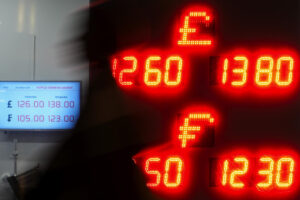The Ruble’s Decline: Navigating Economic Turbulence in Russia
In recent weeks, the Russian ruble has faced significant challenges against various currencies, complicating the government’s efforts to manage consumer inflation while simultaneously ramping up military spending due to the ongoing conflict in Ukraine. As the Russian economy attempts to balance these competing pressures, the consequences of the ruble’s depreciation are becoming increasingly apparent.
As of Friday, the Central Bank of Russia pegged the ruble at a rate of 109 to the U.S. dollar. Just earlier this week, it had dipped to as low as 114. This decline means that the ruble is now worth less than a penny per dollar, throwing the currency into unchartered waters for many citizens. The ruble’s struggles aren’t isolated to the dollar; it has also weakened against the Chinese yuan, which has become increasingly important for Russia’s foreign trade following the sanctions imposed by Ukraine’s Western allies.
Interestingly, many Russians appear to be taking the ruble’s decline in stride. Yekaterina, a Moscow resident, expressed concern over the rising costs of her planned vacation to Egypt but noted the growth of internal tourism as a positive development for the economy. Similarly, another Muscovite, Semyon, downplayed the situation, confidently stating that his salary, taxes, and purchases are all in rubles, implying a disconnect from the global dollar-based economy.
However, the Kremlin’s situation is far from simple. High government spending on military operations has kept factories busy, contributing to an unexpected economic growth rate amid sanctions. Yet, this has fueled inflation, which recently surged to an annualized rate of 8.5% in October. In response, the central bank has ramped up interest rates to a staggering 21% to curb borrowing and consumer spending. This sharp increase in credit costs has not only elicited complaints from businesses but has also raised concerns among economists about the potential for a slowdown in economic growth.
Russian President Vladimir Putin has attributed the ruble’s decline to a variety of factors, including seasonal conditions and shifts in oil prices, attempting to reassure the public that the economic situation is under control. However, experts warn that inflation and currency depreciation remain critical issues for the Kremlin. Janis Kluge, a leading authority on the Russian economy, points out that rising prices and exchange rates are highly visible realities that affect people’s daily lives, making them challenging to dismiss, regardless of government messaging.
The long-term implications of a weaker ruble are concerning, particularly regarding import costs. As the currency loses value, Russians can expect to see increased prices for imported goods—especially automobiles, household appliances, and electronics, which are predominantly sourced from China, now Russia’s primary trade partner.
Several factors have contributed to the ruble’s drop from as high as 85 to the dollar just a few months ago. Lower oil prices, an absence of foreign investments, and rampant inflation all play a role. Furthermore, recent sanctions imposed by the U.S. Treasury against Russia’s Gazprombank have intensified the pressure on the currency. This bank had served as a crucial intermediary for much of Russia’s remaining oil and gas transactions in Europe, and the sanctions have put a strain on the country’s foreign currency inflows.
On the other hand, a declining ruble does have some upsides for the Kremlin. It enhances export revenues in ruble terms for oil and gas, providing a temporary cushion against the economic fallout from sanctions. The central bank, while navigating this tumultuous landscape, has taken steps to control the currency rate amid the shocks from the sanctions. Currently, due to the absence of open market trading for the ruble—again a result of sanctions—the bank itself sets the rate based on its assessments of trade necessities.
Chris Weafer, CEO of Macro-Advisory Ltd, emphasizes that the central bank’s stringent control over the currency market is a strategic approach during these uncertain times. The immediate response to the sanctions has seemingly been to tolerate a ruble depreciation, as it has practical benefits for the finance ministry.
As we look ahead, the central bank will need to carefully balance its strategies to manage inflation with the necessity of maintaining budgetary stability. A potential tactic could involve encouraging exporters to convert more of their foreign earnings into rubles. In this complex environment, the central bank must remain adaptable, continuously adjusting the ruble’s value to reflect shifting economic realities.
The situation remains fluid, and the repercussions of the ruble’s decline will likely continue to ripple through the Russian economy, affecting everything from consumer prices to international trade relations. The resilience and adaptability of both consumers and the government will be tested as this ongoing economic challenge unfolds.
For investors and market watchers, this presents a critical moment to analyze potential opportunities and threats arising from Russia’s evolving economic landscape. Keep an eye on developments, as the dynamics at play could provide unique insights into the future of Russia’s economy and its currency.

